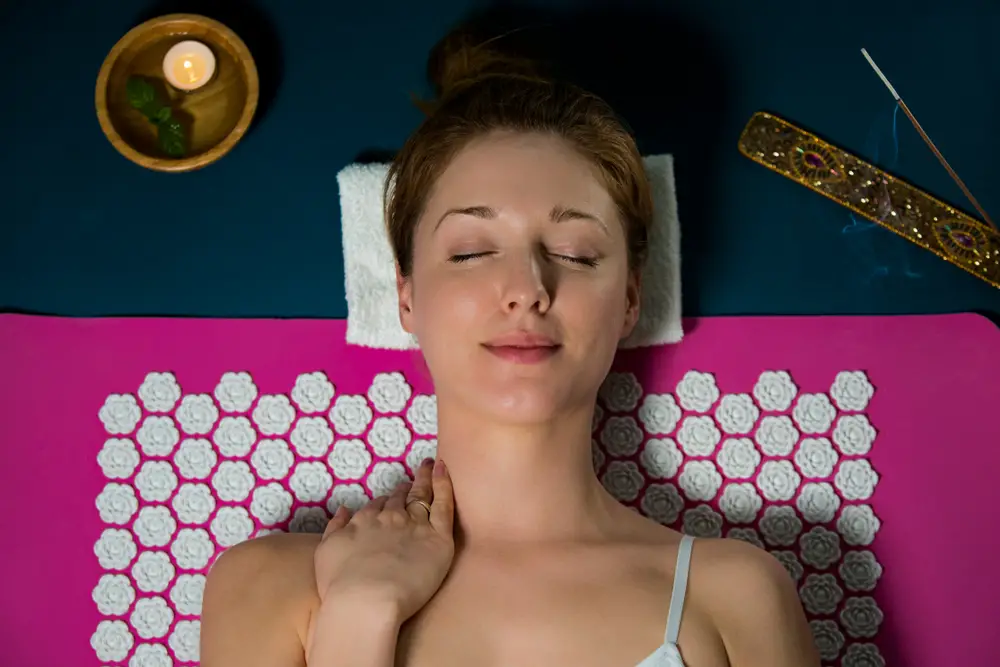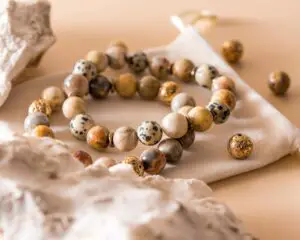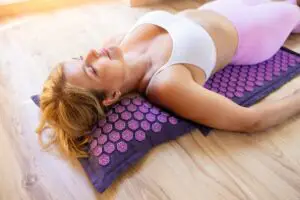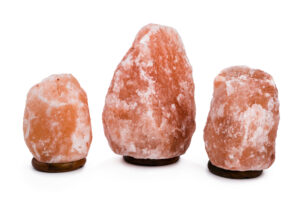Acupressure mats have become increasingly popular as a natural method for relieving pain, reducing stress and anxiety, and improving overall well-being. These mats are designed with thousands of tiny points that stimulate the body’s acupressure points when you lie or stand on them.
The pressure created by the points is believed to help release endorphins, the body’s natural pain-relief chemicals, and promote relaxation. But how long should one spend on an acupressure mat for maximum therapeutic benefits?
Finding the ideal time to spend on an acupressure mat largely depends on the individual’s comfort level and specific needs. For beginners, it’s advisable to start with shorter sessions of around 10 minutes to acclimate to the sensation and gradually increase the duration as the body adjusts. Regular users often find that laying on the mat for 20-40 minutes a few times a week is most effective for reaping the benefits of acupressure mat therapy.
Some people may find relief in shorter sessions of 10-15 minutes, while others could benefit from longer sessions up to 45 minutes. To ensure safety and avoid potential skin irritation, it is generally not recommended to spend more than 30 minutes at a time on an acupressure mat.
As with any wellness practice, it is important to carefully listen to your body’s response and adapt your acupressure mat usage accordingly.
Understanding Acupressure and Acupressure Mats
The Concept of Acupressure
Acupressure is an ancient healing technique that involves the application of manual pressure on specific points in the body, known as acupoints, to stimulate the body’s natural self-curative abilities. By applying pressure to these points, the flow of energy, or Qi, is balanced, which can help alleviate various ailments, such as pain, stress or other health issues.
What is an Acupressure Mat?
An acupressure mat is a modern therapeutic tool designed to help users benefit from the principles of acupressure in the comfort of their own homes. It is typically made of a cushioned material, such as foam or cloth, embedded with thousands of small, plastic spikes. The spikes function like a bed of nails, creating numerous points of pressure across the body.
When a person lies down on the acupressure mat, the spikes gently press against acupoints on the skin, stimulating blood flow and releasing tension. The mat can be used on various parts of the body, such as the back, neck, or feet, depending on the user’s needs and preferences.
To get the most out of an acupressure mat, it is recommended to start with short sessions of around 2 minutes, gradually increasing to up to 20 minutes over the course of few weeks. This helps the body adapt to the sensation and maximise the benefits – which can range from pain relief and stress reduction to improved circulation, sports recovery, and more.
Benefits of Using An Acupressure Mat
Pain and Tension Relief
Acupressure mats can provide significant relief from pain and tension-related issues, such as back pain and muscle tightness. The plastic spikes on the mat apply pressure to multiple points on the body, which helps release tension and promote blood flow. This process is similar to other self-myofascial release tools like foam rollers and massage balls, but acupressure mats work on a larger scale to benefit the whole body.
Better Sleep
If you struggle with sleep, incorporating an acupressure mat into your routine may help. Researchers believe that the use of acupressure mats can have a positive impact on insomnia by stimulating the release of endorphins. These “feel-good” hormones can help you relax and drift off to sleep more easily, resulting in improved sleep quality.
Improved Circulation
Using an acupressure mat can enhance blood circulation, which is crucial for maintaining overall health. By applying pressure to various points throughout the body, acupressure mats encourage blood flow and assist in the delivery of oxygen and nutrients to muscles, tissues, and organs. Improved circulation also aids in sports recovery and alleviating issues such as inflammation and swelling.
Relaxation and Stress Relief
Regular use of an acupressure mat can lead to relaxation and stress relief. The endorphin release prompted by the mat’s pressure points can help reduce anxiety and promote a sense of calm. Spending just 20 minutes a day on an acupressure mat may be enough to experience these benefits. Combining an acupressure mat with mindfulness practices like deep breathing or meditation can further enhance relaxation and stress reduction.
How Long To Use an Acupressure Mat
Initial Usage and Adaptation Period
When first starting to use an acupressure mat, it’s important to give yourself time to adjust to the sensation it provides. Some level of discomfort might be experienced initially, but this is normal as your body is getting used to the pressure points on the mat. To help ease into the experience, you can start by using a thin cloth or towel between your body and the mat. Gradually increase the time spent on the mat as you become more comfortable with the sensation.
In the beginning, you might want to use the acupressure mat for just a few minutes at a time. As your body adjusts to the pressure and you start experiencing the benefits, you can begin to increase the duration of your sessions. Sessions can last anywhere from 2 to 20 minutes, depending on individual preferences and comfort levels.
Long-Term Practice
Once you have become accustomed to using the acupressure mat, a consistent practice is key to maintaining benefits such as reduced stress, muscle tension relief, and improved circulation. Try to incorporate regular sessions into your routine, aiming for at least a few times a week. It is recommended to use the mat for 20 to 30 minutes per session for the best results.
As with any wellness practice, it’s important to listen to your body and make any necessary adjustments to ensure your comfort and well-being. If you ever feel discomfort or pain that persists or worsens during your acupressure mat sessions, consider reducing the duration or frequency, and consult with a healthcare professional if necessary. Remember that consistency and regularity are key, and finding a personal balance will help you to make the most of this beneficial and relaxing practice.
Combining Acupressure Mats with Other Wellness Practices
Acupressure Mat and Yoga
Acupressure mats can be easily incorporated into your yoga routine. They can supplement traditional yoga props like blocks or bolsters. By incorporating an acupressure mat into your yoga practice, you can reap the benefits of both relaxation and stimulation of pressure points.
It can help to enhance muscle relaxation and blood flow, making it particularly beneficial during restorative poses or savasana, where stillness is key. Moreover, using an acupressure mat before or after a yoga session can help in alleviating muscle tension and promoting faster recovery.
Acupressure Mat and Pilates
Pilates is another form of exercise that encourages body and mind connection, and using an acupressure mat can further enhance this connection. Incorporating an acupressure mat into your Pilates practice can help with muscle relaxation, increased blood flow, and reduction of pain.
It can be used as a supplementary tool alongside other Pilates props like foam rollers, resistance bands, and toning balls.
Experimenting with an acupressure mat during stretching or during the cool-down phase post-Pilates class can make the practice even more beneficial and calming.
Acupressure Mat for Gym Warm-up
Acupressure mats can also be utilised as part of your gym warm-up routine. Spending even just a few minutes on the mat before commencing a workout can help stimulate the release of endorphins, which is beneficial for alleviating pain and improving focus during your gym session.
As an added bonus, these mats can also be used as part of your post-workout cool-down routine, assisting in muscle recovery and easing potential aches and stiffness. This versatile addition to your gym bag will certainly contribute to an overall improvement in your exercise experience.
Caring for Your Acupressure Mat
An acupressure mat can be a helpful tool for promoting relaxation and pain relief. To ensure it maintains its quality and remains effective, care and maintenance play an essential role. This section provides tips on how to care for your acupressure mat, ensuring it stays in good condition and allowing you to reap the benefits of your treatment.
Firstly, it is important to store your mat properly when not in use. It should be placed in a clean and dry area, away from sunlight or moisture. If your mat comes with a storage bag, make use of it to protect your mat and keep it free from dust and dirt.
Cleaning your acupressure mat is crucial as it allows you to remove any dirt or bacteria that may accumulate through regular use. To clean it effectively, use a gentle soap and water solution. Dampen a soft cloth with the soapy water and gently wipe your mat’s surface, focusing on the pressure points. Be cautious not to immerse your mat in water, as it may damage the foam or plastic spikes.
After cleaning, allow your mat to air dry in a well-ventilated area, avoiding direct sunlight. This will prevent any mould or mildew from forming due to excess moisture. Ensure your mat is fully dry before using or storing it.
Additionally, inspect your acupressure mat regularly for any worn or damaged areas. If you notice any damaged or broken spikes, you may need to replace your mat to ensure optimal treatment benefits. Remember that a well-maintained mat is a key aspect of a successful acupressure routine.
Specific Techniques and Tips for using Acupressure Mats
Using the Mat for Feet
Using an acupressure mat for your feet can be an excellent way to relieve stress and target the nerves located in this area. Start by placing the mat on a flat surface, such as the floor, and step onto it with your bare feet. Adjust your weight so that you feel the pressure evenly distributed across your foot.
You may also gently rock your feet back and forth or side to side to stimulate various points. Spend around 10 to 15 minutes on each foot for optimal results.
Using the Mat for Legs
Acupressure mats can also be beneficial for the legs, especially if you’re experiencing muscle soreness or tightness. To use the mat for your legs, place it on a flat surface such as the floor or a bed, and lay your legs on top of the mat. Make sure that the pressure points are making contact with the muscles in your legs, especially the calf and thigh areas.
Relax and let the acupressure points work their magic for about 20 minutes. Be sure to maintain a neutral posture and breathe deeply during this time.
Using the Mat for Back Pain
One of the most common uses of an acupressure mat is for alleviating back pain. To effectively target this area, place the Shakti mat, or any other acupressure mat, on a flat surface, and then lie down on it, positioning the mat beneath your lower, middle, or upper back – depending on the location of the discomfort. Initially, you might choose to use a thin layer of cloth, such as a towel, to lessen the intensity of the pressure so you can slowly get used to the sensation.
Ensure that your back is evenly aligned with the mat to apply pressure to key points along the spine and paraspinal muscles. For more targeted relief, try moving your arms above your head or placing a rolled-up towel or pillow beneath your neck. Spend approximately 20 to 30 minutes on the mat, focusing on maintaining your breathing, allowing the acupressure points to stimulate the nerves and alleviate your back pain.
By using these techniques and being mindful of the proper positioning, an acupressure mat can be an effective tool for addressing discomfort in areas such as the feet, legs, and back. Remember to always consult a medical professional, such as a chiro, before incorporating acupressure treatments into your routine, especially if you have a pre-existing condition.
Potential Discomfort and Precautions
Acupressure mats, while generally safe to use, may cause some discomfort for beginners or individuals with certain health conditions. In some cases, poorly designed spikes on low-quality mats might apply too much pressure on specific areas of the body, potentially causing bruising, discomfort, or even injury to the underlying soft tissue.
To minimise the risk of discomfort and facilitate a better experience with acupressure mats, it is advisable to start with shorter sessions. For instance, newcomers should begin using the mat for just 2 minutes and gradually increase the duration over the course of a week or two. Eventually, most users can comfortably spend around 20-30 minutes on the mat without any issue.
When using an acupressure mat, ensure that the mat is placed on a soft, cushioned surface, like a bed or yoga mat, to lessen the impact of the spikes. It is important to be cautious of any underlying medical conditions that may be impacted by pressure points and avoid using the mat if you have open wounds, skin conditions, or are pregnant, unless under specific guidance from a healthcare professional.
Most users can benefit from acupressure mats without any notable complications. However, if you experience persistent pain or discomfort while using the mat, stop the session, and consult a healthcare professional. By following these precautions and understanding the potential for discomfort, you can make the most of your acupressure mat experience while staying safe and comfortable.
My name is Ellis Francis and I have been a personal fitness trainer, sports nutritionalist and health and fitness advisor for over 25 years. I am the lead health and fitness advisor at https://awellnessbody.com.







